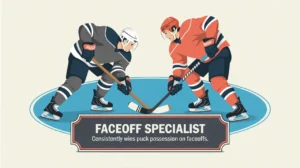Jim’s Intro to the Power Forward
Hi folks, Jim here, the only commentator who once thought “power forward” was a gear option in a stick shift car.
What is a power forward?
A power forward is a player who combines size, strength, and offensive ability to dominate along the boards, protect the puck, and crash the net with purpose. They can score goals, make plays, and physically wear down opponents through direct, hard-driving hockey.
They’re the players who thrive in tough areas, whether it’s muscling through defenders, winning net-front battles, or bulldozing their way into scoring positions.
How does it work?
Power forwards influence the game through a blend of physical dominance, smart positioning, and offensive pressure:
Puck Protection and Board Play
- Power forwards excel at shielding the puck with their body, making it hard for defenders to strip them.
- They cycle the puck effectively, win battles along the wall, and sustain offensive-zone pressure.
Net-Front Presence
- They plant themselves in front of the net, screening goalies, tipping shots, and cleaning up rebounds.
- Their size makes it difficult for defenders to move them, giving their team high-danger opportunities.
Driving the Net
- Power forwards attack the middle with authority, cutting inside defenders and forcing goalies to handle tough in-tight chances.
- Their direct style often draws penalties as defenders struggle to contain them.
Physical Play
- They use their body to finish checks, separate opponents from the puck, and establish territorial dominance.
- Their physicality creates space for linemates and disrupts defensive structure.
Offensive Skill
- Unlike pure grinders, power forwards bring legitimate scoring touch. They can finish plays, set up teammates, and capitalize on chaos they help create.
Common Situations Involving Power Forwards
- Offensive Zone Cycles: Winning battles and extending plays along the boards.
- Net-Front Screens: Causing havoc for goalies and defensemen.
- Rush Opportunities: Cutting to the middle for high-percentage shots.
- Power Plays: Planting in front for tips and rebounds.
- Momentum Shifts: Delivering punishing hits or strong shifts that energize the bench.
How do you make good decisions with it?
Good power forwards rely on controlled aggression and smart reads.
- Pick Your Battles: Use your size to create advantages, not take unnecessary penalties.
- Drive Smart: Know when to cut inside and when to hold the puck for support.
- Establish Position Early: Get to the net-front before defenders can tie you up.
- Work With Linemates: Physical pressure is most effective when synced with passing options.
- Stay Disciplined: Physical play must support the team’s structure, not break it.
How do you master it?
Mastering the power forward role takes strength, conditioning, puck protection skill, and confidence in physical play. Elite power forwards train to battle in tight spaces, keep their feet moving through contact, and make quick decisions under pressure. They also work on finishing in close, because their scoring chances often come from the dirty areas.
What does it look like when done right?
A great power forward charges down the wing, lowers their shoulder, and cuts hard to the net, either scoring or drawing a penalty. In the offensive zone, they win a battle on the boards, hold off two defenders, and feed a teammate in the slot. In front of the net, they set up shop, absorb crosschecks, and tip a shot past a screened goalie.
Commentator’s Corner
Jim’s Take
A true power forward doesn’t knock politely on the door. They kick it down, set up camp in the slot, and invite chaos to dinner.
Parent Tip
If your player plays like a power forward, encourage core strength, balance, and puck protection drills, alongside scoring touch. Dominance in tight areas often decides big games.
Player Tip
Use your body as a weapon, but a smart one. Win space, hold it, and make defenders pay every time they try to push you out.
A Final Thought
Power forwards give teams a physical and offensive edge that shifts games. When mastered, the role blends brute force with finesse, turning tough areas of the ice into prime scoring zones and setting the tone for everyone else on the ice.









